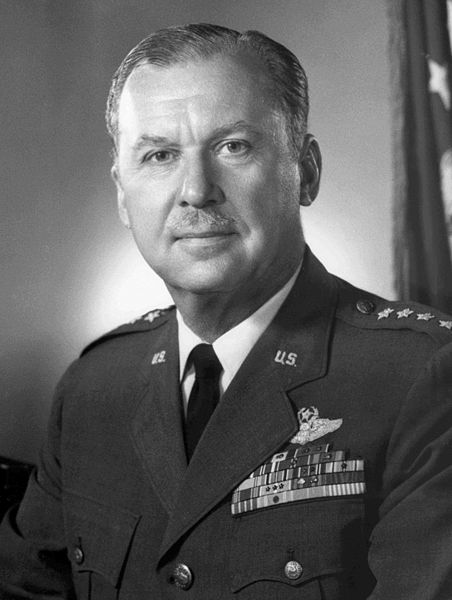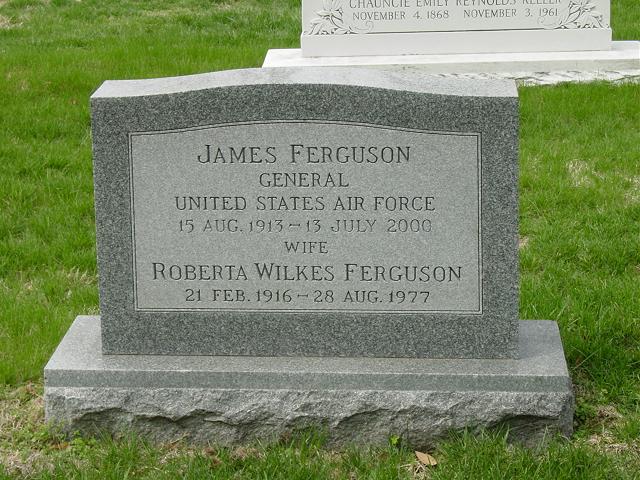From a contemporary press report:
James Ferguson, 86, an Air Force four-star general who retired from active duty in 1970 as head of the Air Force Systems Command, died July 13, 2000 in Venice, Florida. The cause of death was not reported.
General Ferguson, who became a pilot, was commissioned in the Army Air Corps in 1937. During World War II, he served as senior air controller on the night of the Normandy invasion, then helped plan a possible invasion of the Japanese home islands. During the Korean War, he served as vice commander of the Fifth Air Force.
His military decorations included two Distinguished Service Medals, three Legions of Merit, the Distinguished Flying Cross, two Bronze stars and two Air medals.
FERGUSON, JAMES, Gen, USAF (Ret.)
On Thursday, July 13, 2000, in Venice, FL. Beloved husband of Catherine Wood Ferguson. Surviving also are his brothers, Douglas, of Whittier, CA and John, of Laguna Beach, CA. A memorial service for family members was held on Monday, July 17, 2000, in Venice, FL. Interment service at Arlington National Cemetery will be held at 11 a.m., Tuesday, July 25, 2000. For additional information please call Maj. Gen. James Pfautz, USAF, (Ret), in Annapolis at 410-849-8918.
Courtesy of the United States Air Force
GENERAL JAMES FERGUSON
Retired Aug. 31, 1970, Died July 13, 2000
General James Ferguson was commander of the Air Force Systems Command, Andrews Air Force Base, Maryland. This command has the responsibility for providing the weapon systems and meeting the technological needs of the total Air Force mission. It includes laboratories responsible for exploratory and advanced development programs, product divisions for developing and acquiring military systems, as well as test centers to insure the capability of these systems before their use by Air Force operational commands. Specialists in development planning, procurement and production complete the AFSC requirements of the Air Force.
General Ferguson was born in Smyrna, Turkey, of British parents in 1913. He attended elementary school in Scotland and later settled with his family in Whittier, Calif. He became a naturalized United States citizen March 28, 1930; graduated from a local high school in 1931, and from Fullerton Junior College, California, in 1934.
He enlisted in the Air Corps in October 1934, began his flying training a year later and completed it in July 1936. He flew as a flying cadet for one year before being commissioned a second lieutenant in June 1937.
He was assigned in March 1940 to Hamilton Field, Calif., as commanding officer of the 79th Pursuit Squadron. In April 1942, he became executive officer of the 20th Pursuit Group at Charlotte, N.C., and from July 1942 to October 1943, served as commanding officer of the 337th Fighter Group.
In October 1943, General Ferguson organized and commanded the 405th Fighter-Bomber Group at Waterboro, S.C., and took it to Europe four months later. He participated with the 405th Group in preinvasion attacks on enemy-held Europe until his assignment in April 1944 as assistant chief of staff with the 9th Fighter Command. He participated as an air controller on the night of the Normandy invasion and served in various campaigns until the German surrender.
In December 1945 General Ferguson returned to the United States. He later became an instructor in the Tactical Air Section of the Air Command and Staff College, Maxwell Air Force Base, Albama.
General Ferguson was assigned in November 1947 to the U.S. Air Force advisory group in Ankara, Turkey, and later became chief of that group. He departed for the Far East in June 1950, where he served as assistant to the vice commander and later assistant deputy for operations for the U.S. Far East Air Forces. From June 1951 to February 1952, he was vice commander of the Fifth Air Force in Korea.
He returned to the United States and served as deputy commander of the Ninth Air Force of the Tactical Air Command at Pope Air Force Base, North Carolina, and later at Shaw Air Force Base, South Carolina.
In July 1955, General Ferguson began a series of assignments which have kept him in the vicinity of Washington, D.C., for more than 14 years. First, he became deputy and later director of requirements in the office of the deputy chief of staff for development, Headquarters U.S. Air Force. Then he was named vice commander of the Air Research and Development Command (later Air Force Systems Command) with headquarters at Andrews Air Force Base, Maryland.
In December 1961, General Ferguson became deputy chief of staff for research and development at Headquarters U.S. Air Force. In that position he monitored the total research and development effort in the Air Force. In September 1966 he assumed command of the Air Force Systems Command.
His military decorations include the Distinguished Service Medal with oak leaf cluster, Legion of Merit with two oak leaf clusters, Distinguished Flying Cross, Bronze Star Medal with oak leaf cluster and Air Medal with oak leaf cluster, the Most Excellent Order of the British Empire, Croix de Guerre with Palm (France), Croix de Guerre (Luxembourg), and the Military Merit Ulchi Medal with gold star (Korea).
Michael Robert Patterson was born in Arlington and is the son of a former officer of the US Army. So it was no wonder that sooner or later his interests drew him to American history and especially to American military history. Many of his articles can be found on renowned portals like the New York Times, Washingtonpost or Wikipedia.
Reviewed by: Michael Howard


